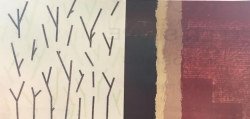Ellen Slupe
August 21-October 5, 2008
Composites

Villanova Art Gallery Opens '08-09 Season With The Sharp-Edged Abstracts by Ellen Slupe
Villanova, PA- Ellen Slupe was nearly 20 years into her chosen field of medical research when she decided to spice up her life with a hobby. She returned to an old love--art--went to back to college, and traded a rewarding career which she enjoyed for a less certain one that she loves.
Far beyond a hobby, art has become an all-consuming passion for the award-winning artist from Lancaster County, PA, whose upcoming exhibit "Composites" launches the 2008-'09 season at the Villanova University Art Gallery.
“The rhythms of daily life are more and more influencing the paintings of Ellen Slupe,” New York Times art critic William Zimmer has written. “Animated by ideas, feelings, and memories,” her work, he notes, “reflects what Baudelaire called, ‘the beauty of circumstance’.”
The reception to meet the artist took place on Friday, September 5 in the art gallery in the Connelly Center on the Villanova campus. It was supported in part by the Pennsylvania Partners in the Arts, the regional arts funding partnership of the Pennsylvania Council on the Arts.
After exploring portraiture, landscapes, and other representative imagery, Slupe arrived at her métier, what Zimmer calls, “essentially geometric abstraction but of a highly personalized sort,” work that brought Slupe first prize in the 2006 Philadelphia Tri State Artists Equity juried exhibition, among other honors.
For Slupe, it is “the crisp edge and repetitious mark-making” that define her thickly-layered paintings. The straight-sided edge she sees as a basic life form, with the repeated mark-making being symbolic of the rhythms and pulses that play at the edge of human consciousness – heart beats, the act of breathing, the passing of a moment, cycles of life, of the moon.
In the repetition of her brush strokes and layering, Slupe acknowledges the influence of the late modern abstract painter Warren Rohrer, a fellow Lancaster County native and long-time teacher at the Philadelphia University of the Arts.
“That constant steady repetition fascinated me and I chose to expand on it, although not as an additive process as he used, but as a subtractive process that scratches away existing surfaces, an erosion rather than a blanket of color.”
“It is the quality of layering that gives greater mystery to these abstract works,” wrote Daina Savage, in reviewing a Slupe exhibit for the Intelligencer Journal newspaper of Lancaster. Indeed, outcomes of her complex paint-and-tape, color-blocking process are veiled from the artist as well.
“If the colors are to work,” Slupe says, “you have to be good at remembering what you’ve hidden under the tape. Sometimes, beautiful color associations surface; other times, the colors are so similar that they seem to disappear.” The artist sees this layering as a metaphor for life experience, signifying the hidden qualities that people carry beneath the surface of their outward presentation.
Slupe’s fascination with repetition as beauty stems from its place as basic to daily life, physical activity, and all learning. “Everything we as individuals know was processed through someone else’s brain,” she notes. The repetition that is central to her work has, she says helped her increase her ability to focus. “Through my work I have found that I can stay focused longer and more intensely that I used to be,” she says.
What especially fascinates Slupe is the straight-sided shape. In her evolution as a painter, she found the crisp edge showing up on her canvases, seemingly from nowhere, to become the essence of her abstractions. “It’s the crisp edge that’s the most important feature of my work,” says the artist.
Perhaps, she says, this component of her paintings is an inheritance from the craftsmanship of her Danish forbears, or it comes from the precision required of her career in medical research. Or possibly it’s a little of the geometric precision that plays such a large part in the quilt designs of her Amish neighbors, perhaps some of all of the above.
“It must be deeply engrained from somewhere. All I know is that once I started using it, the crisp-edged shape began showing up in everything I do,” says Slupe.
Slupe’s work has been extensively exhibited in one-person and group shows across Pennsylvania, as well as in Maryland and New Jersey. Internationally, he art has been featured in invitational exhibits in Florence and Venice, Italy; Japan and South Korea. Her work has been accorded honors by the Pennsylvania Watercolor Society, Lancaster Museum of Art, the York (PA) Art Association, and the Noyes Museum of Art in Oceanville, NJ, among others. She won first prize in the 2002 “Women’s Expressions” National Invitational in Lancaster.
Slupe is a charter member of the National Museum of Women in the Arts in Washington, D.C.; a past board director of Philadelphia Tri-State Artists Equity, and a current board member of the New Art Program of Kutztown, PA. She is also a staff writer for Art Matters magazine.
Prior to her incarnation as a professional artist, Slupe worked as a researcher at the Hershey Medical Center in Hershey, PA, and before that at the Scripps Clinic and Research Foundation at LaJolla, California. She earned a Bachelor of Science degree in pre-med biology at Elizabethtown College and a Bachelor of Fine Arts from Millersville University.


